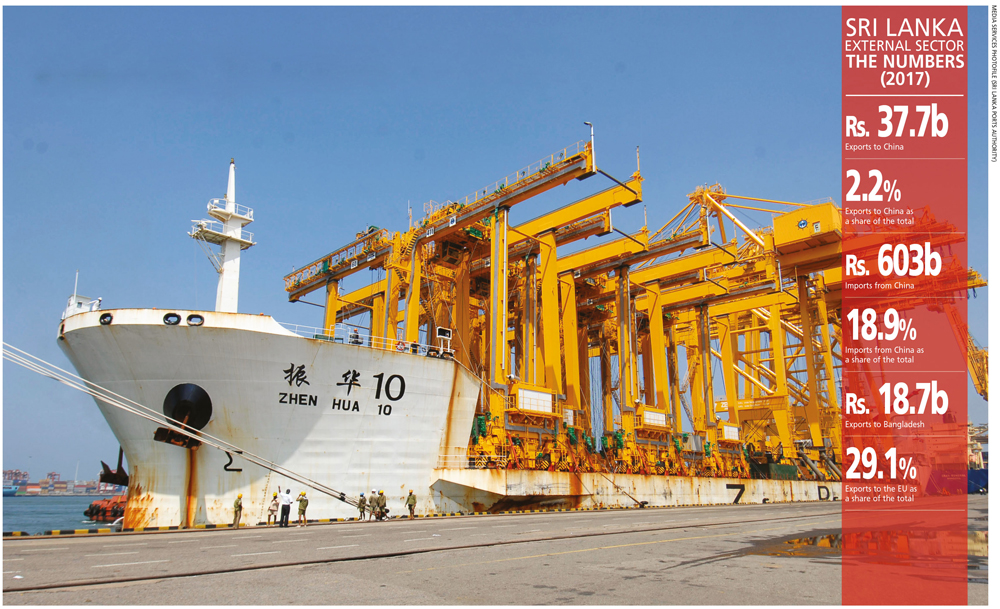TRADE AGREEMENTS
STRIKING A BALANCE ON TRADE
Zulfath Saheed turns her attention to existing and future free trade agreements
The recent constitutional crisis, which lasted for as long as 52 days from 26 October last year, was an eye-opener for many citizens about the fragile nature of politics and potential for instability in Sri Lanka.
On the international front, the political impasse led to travel advisories and the suspension of funding programmes by foreign counterparts. They were visibly concerned by events on the ground and sought to protect themselves against any negative repercussions.
But since the crisis was resolved through the intervention of the Supreme Court of Sri Lanka, the country appears to have returned to a state of relative normalcy – albeit with dark clouds constantly looming on the horizon.
There have also been calls for strengthening trade ties primarily in the region by way of Sri Lanka signing FTAs with neighbouring nations.
STATUS QUO Sri Lanka’s existing trade agreements include bilateral deals such as the Indo-Sri Lanka Free Trade Agreement (ISFTA) and Pakistan-Sri Lanka Free Trade Agreement (PSFTA), as well as multilateral pacts with the South Asian Free Trade Area (SAFTA), Global System of Trade Preferences among Developing Countries (GSTP), SAARC and the Asia-Pacific Trade Agreement (APTA).
ISFTA was signed on 28 December 1998 and came into force with effect from 1 March 2000. It provides duty-free concessions to a wide range of products traded between the two countries.
Sri Lanka’s final tariff liberalisation commitment under the ISFTA came into effect in November 2008 and was fully implemented with effect from March 2000. The island was granted full duty-free access to the vast Indian market under the ISFTA by end-March 2003 whereby entrepreneurs based in Sri Lanka were permitted to export over 4,000 product lines without the imposition of any duties.
Meanwhile, PSFTA came into force on 12 June 2005. According to the Department of Commerce, a notable improvement in trade has been recorded since the agreement came into force. Pakistan implemented its final phasing out commitment in March 2009 and Sri Lanka now has duty-free market access for more than 4,500 products. The latter completed its phasing out commitments in November 2010.
REGIONAL PACTS Proposed free trade agreements include those with Bangladesh and China.
Whereas the FTA with Bangladesh was expected to be signed during the tenure of the former Bangladeshi administration – given that the feasibility studies had already been completed especially going by reports quoting former Bangladeshi Commerce Minister Tofail Ahmed in October last year – the agreement remains in the planning stages. This FTA is set to cover duties, services and investment.
The FTA between Sri Lanka and China is expected to be signed this year, according to news reports citing the Sri Lankan embassy in Beijing, with the sixth round of talks to forge the trade pact concluding in March 2017. Speaking to reporters in January, Sri Lanka’s ambassador to China Karunasena Kodituwakku noted that his country remained keen to grow its exports to the Chinese market.
In June 2018, FTA negotiations between Sri Lanka and China reached an impasse primarily due to the latter refusing to accede to Sri Lanka’s request to review the deal after a period of 10 years.
TRADE POLICY Calls for a National Trade Policy have also been commonplace in recent years and last November, amidst the reign of the short-lived interim government, cabinet approval was to be sought to go ahead with it.
It is worth noting that this temporary regime also sought to revise the terms of the recently signed Singapore-Sri Lanka FTA.
At the same time, the ‘New Trade Policy’ document published by the Ministry of Development Strategies and International Trade in June 2017 aims to “attract more export oriented foreign direct investment (FDI), to improve trade logistics and trade facilitation, and to implement other measures to boost firms’ ability to compete in global markets…”
It also seeks to “ensure that effect of tariff and para tariff reductions are contained in government revenue, and in the trade balance.”
FARTHER AFIELD In addition to potential deals already in the pipeline, experts argue that it may be opportune for Sri Lanka to look beyond the region in formulating trade agreements for the country.
The EU is one such example that has been identified with the Generalised System of Preferences Plus (GSP+) benefits scheduled to run until 2023. While there are concerns about the UK in the light of the Brexit conundrum, the EU market is expected to grow.
Of course, domestic resistance to FTAs has not been uncommon in Sri Lanka – they will also require due consideration in the months and years ahead.




